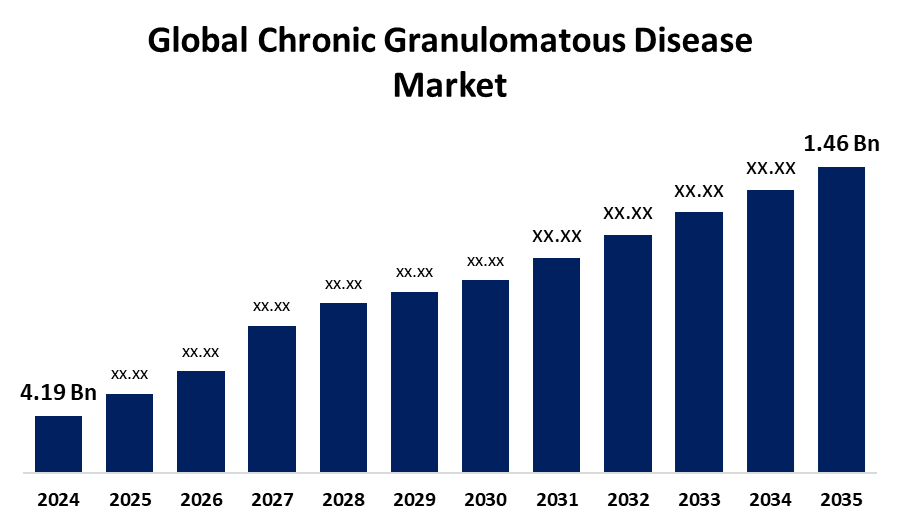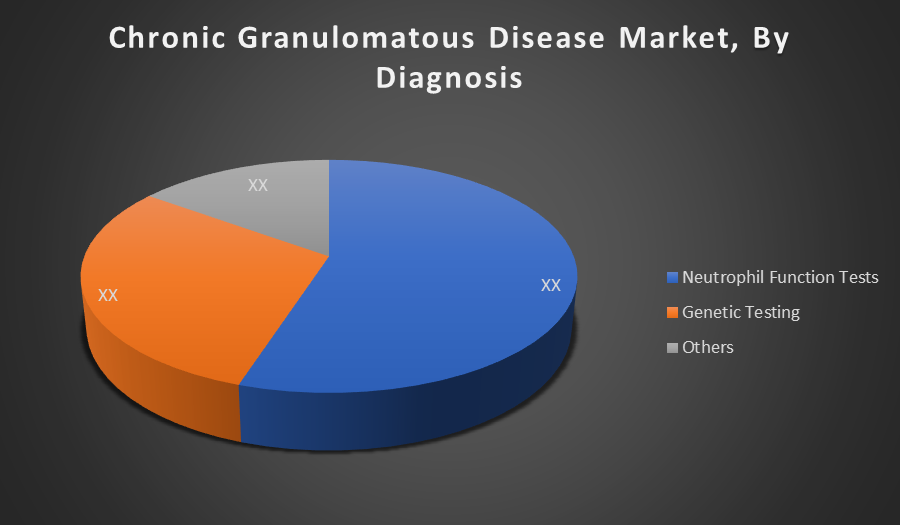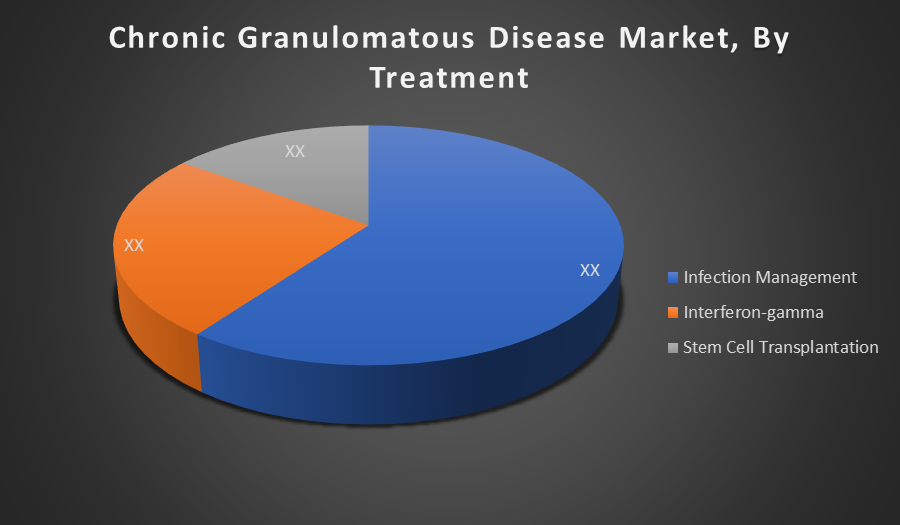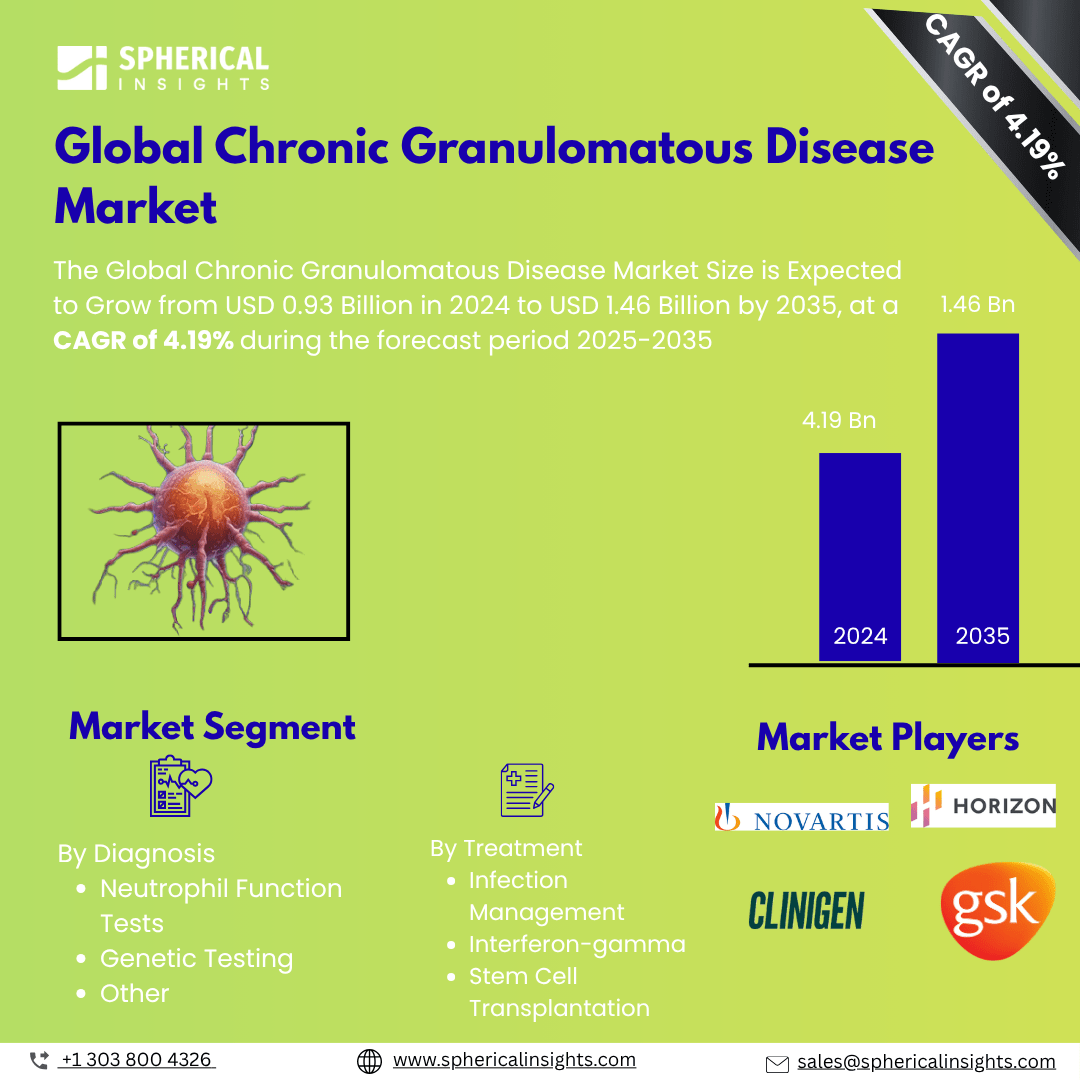Chronic Granulomatous Disease Treatment Market: Understanding and Treatment Algorithm:
Chronic Granulomatous Disease (CGD) is a rare genetic immune disorder where white blood cells cannot effectively kill certain bacteria and fungi. This results from defects in the NADPH oxidase enzyme complex, leading to recurring, severe infections and granuloma formation in organs. CGD typically appears in childhood and requires lifelong management

Chronic Granulomatous Disease Diagnosis:
Diagnosis of Chronic Granulomatous Disease (CGD) involves tests that assess immune cell function and genetic mutations. The dihydrorhodamine (DHR) flow cytometry test is commonly used to measure neutrophil oxidative burst activity. Genetic testing confirms the specific mutation, helping determine inheritance patterns and guiding treatment, family counseling, and potential gene therapy eligibility.
Chronic Granulomatous Disease Treatment:
Treatment of Chronic Granulomatous Disease (CGD) focuses on preventing and managing infections through lifelong antibiotics and antifungal medications. Interferon gamma may be used to boost immune function. In severe cases, hematopoietic stem cell transplantation (HSCT) offers a potential cure. Emerging gene therapies are also being explored as long-term treatment options.
Chronic Granulomatous Disease Epidemiology
The disease epidemiology covered in the report provides historical as well as forecasted epidemiology segmented by Total Diagnosed Incident Population of Chronic Granulomatous Disease, Gender-specific Diagnosed Incidence of Chronic Granulomatous Disease, Type-specific Diagnosed Incidence of Chronic Granulomatous Disease, Age-specific Diagnosed Incidence of Chronic Granulomatous Disease, Diagnosed Incident Population based on Primary Site of Chronic Granulomatous Disease, and Diagnosed Incident Population based on Histologic Classification of Chronic Granulomatous Disease Tumour in the global market covering North America, Europe, Asia-Pacific, Latin America, the Middle East, and Africa from 2024 to 2035.
Principal Insights
This section offers a global overview of chronic granulomatous disease epidemiology in major markets worldwide.
Country Wise- Chronic Granulomatous Disease Multiforme Epidemiology
- The epidemiology segment provides chronic granulomatous disease prevalence data and findings across key regions worldwide, including North America, Europe (Germany, France, Italy, Spain, and the United Kingdom), Asia-Pacific (including Japan), Latin America, the Middle East, and Africa.
Chronic Granulomatous Disease: Recent Developments:
- In April 2024, Prime Medicine obtained FDA clearance for its Investigational New Drug (IND) application for PM359, allowing initiation of a global Phase 1/2 trial in the U.S. targeting p47^phox CGD. This marked the first-ever IND approval for a Prime Editing therapeutic, representing a major milestone in gene editing treatment development for rare diseases.
Chronic Granulomatous Disease Marketed Drugs:
- Actimmune (interferon gamma 1b): Amgen
Actimmune is a recombinant interferon gamma therapy approved to reduce the frequency and severity of serious infections in CGD patients. It enhances neutrophil function and has been shown to decrease serious infection rates by around 64 70 in clinical trials, making it a critical immunomodulator in standard prophylaxis.
- Trimethoprim-sulfamethoxazole (co trimoxazole): Generic antibiotic
This broad spectrum antibiotic is widely used as a first-line prophylactic agent to prevent bacterial infections in CGD. Administered long-term (often lifelong), it significantly reduces recurrent infections without substantially disrupting the gut microbiome.
- Itraconazole: Generic antifungal
Itraconazole is the main oral antifungal used for preventing fungal infections in CGD. Recommended as long-term prophylaxis, it effectively reduces fungal infection incidence and is supported by randomized controlled trials.
- Itraconazole: Generic antifungal
Itraconazole is the main oral antifungal used for preventing fungal infections in CGD. Recommended as long-term prophylaxis, it effectively reduces fungal infection incidence and is supported by randomized controlled trials.
Chronic Granulomatous Disease: Emerging Therapies:
• PM359:It is an ex vivo prime editing therapy targeting p47phox CGD. It received FDA clearance for its IND application, allowing a global Phase 1 2 trail to begin. This program uses patient derived hematopoietic stem cells corrected outside the body before being reinfused, offering a precise gene correction approach
•EN 374: It is a novel in vivo HSC targeted gene therapy for x linked CGD. It secured FDA rare pediatric disease and orphan drug designation, with an IND Filing expected in the first half of 2025. The therapy delivers a function CTBB gene directly to stem cells within the patient, aiming to simplify treatment compared to ex vivo method
- Lentiviral Gene Therapy: An experimental lentiviral based gene therapy for X linked CGD has shown promising early results: six out of nine treated patients remained infection free between 12 and 36 months post treatment, with stable restoration of NADPH oxidase activity. Collaborative trials are expanding under a Genentech Orchard Therapeutics partnership.
•PM359: Prime Medicine reported breakthrough clinical data from its Phase 1 2 trail: a single infusion of PM359 restored NADPH oxidase activity in 66% of neutrophils by day 30, with rapid engraftment by day 14, and without serious adverse events.
Chronic Granulomatous Disease Market Outlook
- The Chronic Granulomatous Disease (CGD) market encompasses the global landscape of diagnostic tools, therapeutic interventions, and gene-based treatments used to manage or cure CGD, a rare genetic immune disorder that impairs the body's ability to fight bacterial and fungal infections.
- Key drivers include rising awareness of rare genetic disorders, increasing availability of genetic and neutrophil function testing, advances in stem cell transplantation and gene therapy, and strong support from non-profit organizations promoting early diagnosis, patient care, and funding for innovative treatment research.
- Emerging gene-editing technologies like CRISPR and prime editing, increased investment in rare disease therapeutics, rising healthcare access in developing nations, and collaborations between biotech firms and academic institutions offer significant growth opportunities for developing effective, curative therapies for CGD patients worldwide.
- Governments have launched orphan drug programs, provided rare disease funding, and established newborn screening policies to identify immunodeficiencies like CGD early. Regulatory bodies also offer fast-track designations and financial incentives to accelerate the development and approval of advanced treatments for rare immune conditions.
- High treatment costs and limited patient population restrict commercial viability for many CGD therapies.
- The market is expected to grow primarily due to the rapid advancement and clinical success of gene and cell-based curative therapies.
Chronic Granulomatous Disease Market Segmentation
By Diagnosis:
- Neutrophil Function Tests
- Genetic Testing
- Others

Neutrophil Function Tests hold the largest share in the diagnosis segment due to their crucial role in early and definitive detection of Chronic Granulomatous Disease (CGD). These tests are widely accessible, cost-effective, and offer rapid results, making them a standard first-line diagnostic tool globally.
By Treatment:
- Infection Management
- Interferon-gamma
- Stem Cell Transplantation

Infection Management dominates the treatment segment, as it remains the primary approach for controlling CGD related complications. It includes long-term use of antibiotics and antifungals, which are more widely adopted than advanced therapies like stem cell transplantation, due to lower costs, broader availability, and fewer associated risks.
Regional Segment Analysis of the Chronic Granulomatous Disease Market
North America holds the largest share in the Chronic Granulomatous Disease (CGD) management market. This dominance is driven by its well developed healthcare infrastructure, strong government funding for rare disease research, high awareness levels, and concentration of industry players. Robust diagnostic and treatment capabilities and significant R D investments underpin its leadership position globally.
Asia Pacific is the fastest growing region in the CGD market. Growth is fueled by rapidly developing healthcare systems, increasing prevalence awareness, expanding government initiatives, and rising private investments. Strong momentum in diagnosis and treatment adoption, especially in India, China, and Southeast Asia, is propelling notable CAGR expansion compared to other regions.
China, and Southeast Asia, is propelling notable CAGR expansion compared to other regions.
Chronic Granulomatous Disease Market Key Companies
- Clinigen Group plc
- Orchard Therapeutics plc
- Horizon Therapeutics plc
- ViroMed Co. Ltd
- Bellicum Pharmaceuticals Inc
- Pfizer Inc
- Hoffmann La Roche Ltd
- Novartis AG
- Lonza
- GlaxoSmithKline plc
- Eli Lilly and Company
- Johnson Johnson Services, Inc.
- Merck KGaA
- AVROBIO, Inc.
- Rocket Pharmaceuticals
- Others
Chronic Granulomatous Disease Therapeutics Market Report Scope
- The Chronic Granulomatous Disease therapeutics market report provides a detailed overview, covering its causes, symptoms, disease progression, and existing treatment options.
- Detailed insights into Chronic Granulomatous Disease’s epidemiology and therapeutic approaches are included.
- Additionally, a comprehensive review of existing and emerging Chronic Granulomatous Disease therapies is provided, including an evaluation of new treatments expected to influence the current Chronic Granulomatous Disease treatment market landscape.
- The report includes a detailed review of the Chronic Granulomatous Disease therapeutics market, both historical and forecasted, highlighting the global drug reach.
The Patient Based Chronic Granulomatous Disease Market Forecasting report offers valuable insights into trends shaping the global Chronic Granulomatous Disease market, helping to develop effective business strategies
Chronic Granulomatous Disease Treatment Market Report Insights
- Forecasting Market Trends Based on Patient Data and Disease Rates
- Chronic Granulomatous Disease Therapeutic Approaches in Chronic Granulomatous Disease
- Review Of Drugs in Development for Chronic Granulomatous Disease
- Market, Growth, and Trends in Chronic Granulomatous Disease
- Market Opportunities in Chronic Granulomatous Disease Treatment
- Effects Of Future Therapies on Chronic Granulomatous Disease Treatment.
Chronic Granulomatous Disease Treatment Market Report Key Strengths
- 15 Years Chronic Granulomatous Disease Market Forecast
- Global Coverage
- Chronic Granulomatous Disease Epidemiology Segmentation
- Key Cross Competition
Chronic Granulomatous Disease Treatment Market Report Assessment
- Present Practices in the Chronic Granulomatous Disease Treatment Market
- Review of Investigational Chronic Granulomatous Disease Drugs
- Attractiveness of the Chronic Granulomatous Disease Drug Market
- Chronic Granulomatous Disease Market Drivers
- Chronic Granulomatous Disease Market Barriers
- SWOT
- Attribute Analysis
Market Segment
This study forecasts revenue at the global, regional, and country levels from 2020 to 2035. Spherical Insights has segmented the chronic granulomatous disease market based on the below mentioned segments:
Global Chronic Granulomatous Disease Market, By Diagnosis
- Neutrophil Function Tests
- Genetic Testing
- Others
Global Chronic Granulomatous Disease Market, By Treatment
- Infection Management
- Interferon gamma
- Stem Cell Transplantation
Global Chronic Granulomatous Disease Market, By Regional Analysis
- North America
- Europe
- Germany
- UK
- France
- Italy
- Spain
- Russia
- Rest of Europe
- Asia Pacific
- China
- Japan
- India
- South Korea
- Australia
- Rest of Asia Pacific
- South America
- Brazil
- Argentina
- Rest of South America
- Middle East & Africa
- UAE
- Saudi Arabia
- Qatar
- South Africa
- Rest of the Middle East & Africa






